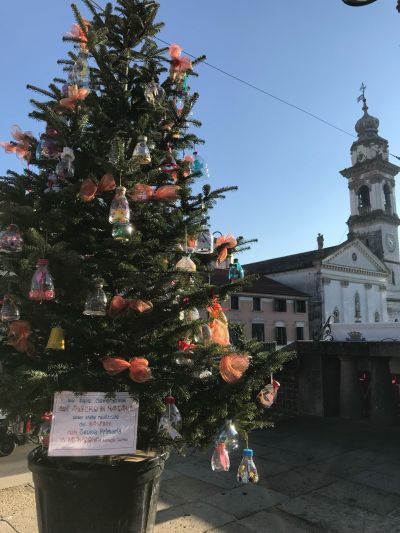The weeks leading up to Christmas were pleasurable here, as opposed to frenetic and commercialized as they are elsewhere.
The local Christmas Market along the canal was the first event, with the rowing club (all dressed as Santa Claus) taking visitors for a short ride to the castle and back, past the superb floating nativity (Presepio sull’Acqua), an annual creation where life-size figures are arranged on several boats to represent Mary, Joseph and the Christ Child (who finally appears in the manger on Christmas Day), a boat of shepherds and sheep, a boat containing three exotic kings, and another larger boat to represent the locals, all mechanical working models including a cobbler, a woman stirring a cauldron of polenta, a man pressing olives, a barrel maker, a drunkard drinking from a bottle while his dog wags its tail, two men sawing a log…and more.
This year I was invited to the Christmas Feast at the Canal Museum, where remarkably, they conjured up a four-course meal from thin air! (The museum has no kitchen.) We enjoyed Treviso radicchio wrapped around with prosciutto, radicchio and pomegranate risotto, baked sea bream in tomato, olive and caper sauce, and three desserts. There was ample local wine, including Prosecco for the tarts and cakes, and lots of chat about boats in particular. In fact, the day before, a gondola had been turned over in Venice by its badly behaved tourist passengers who ended up in the canal.
All the local villas decorated their rooms to hold concerts and events, and the village put up its modest festive decorations on the lamp posts and bridges. In the center of the main bridge, the only Venetian-style bridge outside Venice, the local primary school erected a tree decorated with baubles made by the pupils from plastic bottles. It was most impressive.
All the celebrating builds up to a climax over Christmas itself, when Babbo Natale is driven though the village on a cart pulled by a white pony. He throws sweets for the children.
Once the new year has been celebrated, the whole region seems to fall asleep. The castles and villas close for winter and some of the restaurants and wine bars reduce their hours or close for a month or more, while their owners seek winter sunshine holidays when the tourists are away. One local bar stays open, though.
One afternoon the Count walked in. It’s only a short walk from his stunningly beautiful villa, and he needed a quick coffee and to tell us all that his wife, the Countess, had just walked into a door and there was a lot of blood from her nose. This tidbit of gossip fuelled the customers for days. We expressed our sympathy while looking up from our aperitivi: Aperol Spritz, and the newly fashionable Cynar Spritz, made from artichokes.
Even in Venice, the narrow alleyways are quiet and gondoliers are dressed in their dark navy winter uniforms, spending their time drinking wine and nibbling cichetti with few customers. The current exhibitions in the main museums (Titian in the Accademia, and Duchamp in the Guggenheim) close in January and February and a silent, misty calm settles over La Serenissima. It’s almost as if Venice was resting, gathering strength for the next season’s invasion to do its worst. (This year there will be an attempt to control numbers of tourists with a daily tax of €5.)
Winter weather in the Veneto is often surprisingly cold, with the air drifting down from the Dolomites. When I open the shutters each morning, I often can’t see the nearby hills for the thick mists which the sun usually penetrates by 10 o’clock. The ground is often frosty, but snow is quite rare except on higher ground. The municipality does have a snow plough, and even a mini-plough for the pavements, but they’re seldom used. People in the towns hurry about their business in a uniform of black padded coats and woolly hats, although some hardy creatures can’t give up the habit of sitting in the chill outdoors for a quick coffee at a favorite bar.
I know that by March a certain pulse will begin again, as slowly the lively hospitable Italy we know and love returns to what it does best, La Dolce Vita.



